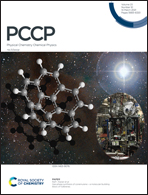Pentagonal B2C monolayer with extremely high theoretical capacity for Li-/Na-ion batteries†
Abstract
Recently, two-dimensional (2-D) materials with a Penta-atomic-configuration such as Penta-graphene have received considerable attention because of their potential applications in electronics, spintronics and ion batteries. Previously, Penta-graphene has been proposed as an excellent anode material for Li-/Na-ion batteries with a high theoretical capacity (1489 mA h g−1). Here, based on the first-principles calculations, we report that a new 2-D material namely Penta-B2C can become another excellent anode material with even higher theoretical capacity for Li-/Na-ion batteries than Penta-graphene. Our results demonstrate that Li/Na atoms can be stably adsorbed on Penta-B2C. Meanwhile, Penta-B2C shows metallic conductivity during the adsorption. Most strikingly, the theoretical capacities of Penta-B2C are as high as 1594 for Li and 2391 mA h g−1 for Na, which are superior to those of the most known 2-D anode materials. Especially, the Na theoretical capacity of Penta-B2C sets a new record among known 2-D anode materials. In addition, Penta-B2C possesses relatively low open-circuit voltage and a low diffusion barrier for ions, which are vital for anode materials. These results highly promise that Penta-B2C can be an excellent anode material with a fast charge/discharge rate and extremely high theoretical capacity for Li-/Na-ion batteries.



 Please wait while we load your content...
Please wait while we load your content...